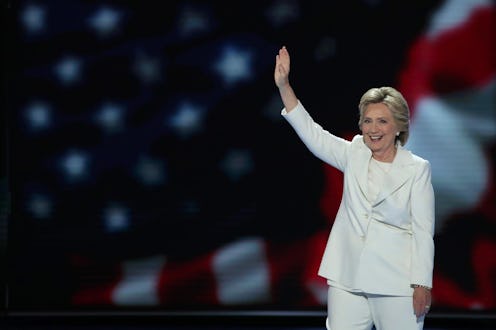Hillary Clinton made an indelible mark in the history books last night as she officially accepted a major party’s nomination as its presidential candidate. (As an aside, the white pantsuit she wore to do so was symbolic—white was one of the official colors of the suffrage movement. Days after the convention wrapped, a spokesperson for Ralph Lauren confirmed that the smart ensemble was contributed by the designer.) Though Hillary deserves more credit for her perseverance than we could possibly find words to express—how many of us would return to be potentially publicly rejected for a job we’d been publicly rejected for once before?—she didn’t get where she is today in a vacuum. Here, 11 women who paved the way for Hillary to shatter the glass ceiling into a million tiny and, hopefully, unrepairable pieces last night.
In 1872, Victoria Woodhull ran for president under the Equal Rights Party, with a platform that included universal suffrage (50 years before women achieved the right to vote), civil rights and social welfare. As her running mate, Victoria chose former slave and prominent abolitionist Frederick Douglass. It's unclear whether or not she received any votes—she couldn't even vote for herself—but her campaign was historic nonetheless. She told the New York Herald, "I … claim the right to speak for the disenfranchised women of the country, and believing as I do that the prejudices which still exist in the popular mind against women in public life will soon disappear, I now announce myself as candidate for the Presidency.” How crazy is it that, nearly 150 years later, we're still fighting her fight?
Belva Lockwood broke more than one barrier. She was one of the first female attorneys in the United States, and she was the first female attorney ever to argue before the Supreme Court, a privilege she was afforded in 1879. She ran for president under the Equal Rights Party and, given that women could not vote and the media at the time was largely against her candidacy, it's somewhat amazing that Belva received around 4,000 votes in her favor.
The easiest way to imagine Gracie Allen's campaign is to think of Stephen Colbert running for president as his satirical alter ego. Gracie entered the race as a stunt, intending to promote her radio show, The Hinds Honey & Almond Cream Program Starring George Burns and Gracie Allen, which is something we're also hoping Amy Schumer will do in 2020. In a campaign speech, Gracie said, "My opponents say they're going to fight me till the cows come home. So, they admit the cows aren't home. Why aren't the cows home? Because they don't like the conditions on the farm. The cows are smart. They're not coming home till there's a woman in the White House."
Margaret Chase Smith was the first woman elected to both the House and the Senate. After 32 years in Congress, she ran for president in the Republican primary. She lost to Barry Goldwater, but she made history anyway as the first woman to be put up for nomination by a major party.
Shirley Chisholm is someone we'd probably already know more about had our history textbooks not all been written by men (wink, wink ... but seriously). She was the first African-American woman elected to Congress, in 1968, and she ran for president in 1972 as a Democratic primary candidate. She won 28 delegates but did not ultimately secure her party's nomination.
Self-described housewife Ellen McCormack ran for president because she wanted to overturn Roe v. Wade. She did not secure her party's nod—at that time, though it seems counterintuitive now, she identified as a Democrat—but she did get on the ballot in more states than any female candidate had before her.
Geraldine Ferraro—who had served three terms in Congress—became the first female vice presidential candidate as Walter Mondale's running mate in 1984. They were defeated by Ronald Reagan.
Patricia Schroeder was the first female Congressperson in Colorado and the first woman to serve on the House's Armed Services Committee. She ran in the Democratic primaries in 1988 with the slogan, "I think America is man enough to vote for a woman." (Again, we must reiterate how crazy it is that this is still a thing nearly 30 years later!) She pulled out of the race with a tearful address, for which she reportedly still receives hate mail to this day (the tear, that is).
In 1988, Lenora Fulani became the first African-American and the first woman to be placed on the ballot in all 50 states—breaking more than one glass ceiling at a time. She ran under the New Alliance Party in the hope of ending the two-party system. She received the most votes for president that any female candidate had received to date, though she ultimately did not win the office.
If ever there were an American success story, it belongs to Madeleine Albright. The former Secretary of State immigrated to the United States with her family in 1948. She became a US citizen in 1957 and joined the College Democrats of America. Over time, she became more and more deeply embedded in US politics, and even served as an adviser to vice presidential candidate Geraldine Ferraro in 1984. In 1993, President Bill Clinton appointed Albright as the US Ambassador to the United Nations, and in 1997, she became the first female Secretary of State, paving the way for Condoleezza Rice and, of course, Hillary Clinton to hold the office in the years that followed.
Time Magazine called environmental activist and physician Jill Stein's 2012 campaign as a Green Party candidate for president "the most successful ever conducted by a woman." She is on the ballot this year as well.
